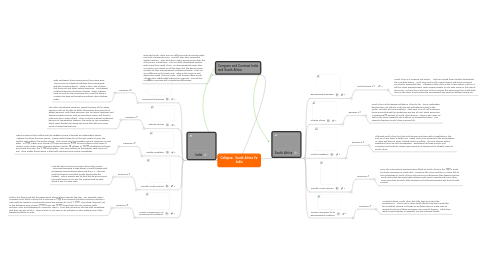
1. India
1.1. Enviromental Damage
1.1.1. Receives a 8
1.1.1.1. India endangers there environment three main ways. There is ton of industrial pollution that is increasing with the economic boom. There is also a ton of dams that hurts soil and other natural resources. The biggest problem being the shortage of water. Water is being used so much by big companies for crops that there is a water shortage and people go without clean drinking water.
1.2. Climate Change
1.2.1. Receives a 7
1.2.1.1. Like other developing countries, several sections of the Indian populace will not be able to buffer themselves from impacts of global warming. With close economic ties to natural resources and climate sensitive sectors such as agriculture, water and forestry, India may face a major threat. There is drops in wheat production because of temperature changes, less snow on the mountains, which cause floods and raising sea levels that will soon cover much of Indias farming land.
1.3. Hostile Neighbors
1.3.1. Receives a 8
1.3.1.1. India has always had conflicts with its neighbors since it became an independent nation. Pakistan has been the main source. Things cooled down but in the last couple of years the conflict with Pakistan has gotten worse. They argue over the boarders and put sanctions on each other. In 2008 Indian army issued a 36-hour warning to 5,000 to leave villages north-west of Jammu, in the Indian state of Jammu-Kashmir. Earlier, 24 villages of 10,000 inhabitants had been evacuated from near the 1,100-mile border. They sent soldiers to the boarder with rumors of war. What makes things worse is that both countries have nuclear capabilities.
1.4. Friendly Trade Partners
1.4.1. Receives a 3
1.4.1.1. India has been having a economic boom this century. India was becoming a huge player in world trading with its biggest partners being China and the U.S. This was until the financial crisis that maybe shook india the hardest. India's exports got hit hard but he government has made laws to try to get the trading back on path which it has at a slow pace.
1.5. Society's Response to its Environmental Problems
1.5.1. Receives a 8
1.5.1.1. Reform has been tried but the government almost always repeals the laws. For example, India's Supreme Court lifted a ruling that it imposed in 1999 that required all public transport vehicles in New Delhi to switch to compressed natural gas engines by April 1, 2001. This ruling, however, led to the disappearance of some 15,000 taxis and 10,000 buses from the city, creating public protests, riots, and widespread "commuter chaos." They did not replace this law with something else they just got rid of it. There is also no real caps on air pollution or dam making, two of the biggest problems in India.
2. Compare and Contrast India and South Africa
2.1. India and South Africa are very different and very similar when you look at Dimonds scare. First off, they have somewhat similar histories. They both have newer governments after the old one was overthrown. They are both developing nations, india more then South Africa. On environmental issues they are similar, not exactly on all the issues but the governments reaction to their environmental problems is similar. They are very different on the trade rout. India is alot more up and down then South Africa in trade. With foreign affairs South Africa is very stable while India is the opposite. Overall they are similar countries will a couple big differences.
3. South Africa
3.1. Environmental Damage
3.1.1. Would receive a 7.
3.1.1.1. South Africa is a resource rich nation. This has caused them troubles throughout the countries history. As of now, coal is still a major export and many resources are used to accomplish this. Although South Africa is the richest nation in africa, it still has huge unemployment rates causing people to rely even more on the natural resources. To keep this a vital part of the economy the government has made little laws on the topic of protecting the environment and capping drilling, mining etc.
3.2. Climate Chane
3.2.1. Receives a 6
3.2.1.1. South Africa is the biggest polluter in Africa by far. This is misleading because they are still not in the top ten polluting countries in the world. But they do have problems. They emit a ton of co2 and green house gases through the production and use of coal, which generates a staggering 90 percent of South Africa energy. There is also many oil spill on the coast caused by the traffic of oil transmitting ships. This severely threatens South Africa's marine life.
3.3. Hostile Neighbors
3.3.1. Receives a 2
3.3.1.1. Although South Africa has had much tension and wars with it neighbors in the past as of now there is hardly any. South Africa tries at times to the peacekeeper in Africa and have at times, helped resolve conflicts. The only tension with is neighbors has to do with immigration. Zimbabwe has huge poverty and unemployment and this causes large amounts of immigrants to illegally move to South Africa.
3.4. Friendly Trade partners
3.4.1. Receives a 1
3.4.1.1. Since the international sanctions were lifted on South Africa in the 1990's trade has been increasing at rapid rates. Countries like China and the U.S were fast to take advantage of South Africas rich resources and become their biggest partner. South africa also has great trade relations with Israel, Canada and many other. Some countries are still a little hesitant on the the government but that is hardly present.
3.5. Society's Response to its Environmental Problems
3.5.1. Receives a 7
3.5.1.1. As stated above, South Africa has little laws to protect the environment. This is not to some small efforts have been made like the President vowing to change air pollution laws or make caps on mining, but none of these promises ever come to fruition. Other laws made have loopholes or generally are not enforced strictly.
